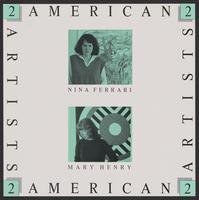(7,481 - 7,500 of 10,082)
Pages
-

-
Title
-
Interview with Larry Wilson: Photos
-
Creator
-
Gonzalez, David, Curtis, Brian, Molitsky, Michael, Thai, Christopher
-
Date
-
2015-10-08, 2015-10-08
-
Description
-
Larry Wilson is an electromechanical repair hobbyist, and has been one for most of his life. As a seventeen-year-old, Larry came across his...
Show moreLarry Wilson is an electromechanical repair hobbyist, and has been one for most of his life. As a seventeen-year-old, Larry came across his hobby when he discovered a Coke machine at a party. Larry was captured by the sleek look of the 1950’s themed machine and, with an initial investment of $75, launched his lifelong fascination. Although his parents disproved of him smuggling and concealing the Coke machine in his room for months, Larry’s intrigue never left him. He would later enroll at Triton College in Illinois to major in heating, ventilation, and air conditioning in order to learn how to fix the Coke machine that he had bought. After realizing the simplicity of repairing the Coke machine, Larry realized that he especially enjoyed working on machines and fixing them. As a result, he decided to return to college to study electrical engineering. From there, his electromechanical collection grew with the addition of a jukebox and another Coke machine. Today, Larry owns an impressive electromechanical machine collection that ranges widely from pinball cabinets to shooting galleries to vending machines that are reminiscent of the 1960s era and his childhood. The machines have a high attraction value for visitors and mainly see action when special events and holidays are hosted in Larry’s home. Many of the machines in Larry’s collection are repaired and restored by Larry himself and are also maintained by his son, Kyle. Larry often figures out how to repair his electromechanical machines by studying schematics closely. While repair times for the machines vary widely depending on the accessibility of specific parts and the complexity of the machine, Larry estimates that 100 man-hours are needed to return a broken machine to working order. Because electromechanical repair is a niche area and quite labor intensive, Larry maintains that repairing machines will remain as a hobby for him. In order to obtain machines or parts to repair his machines, Larry consults with other members of a large and supportive network that specializes in electromechanical machines. As a result, Larry regularly enjoys contact with other hobbyists and specialists from all over the United States at large conferences – some that are hosted in Chicago. While at these conferences, Larry oftentimes finds machines that are worth repairing or scrapping for parts, as well as meeting other like-minded peers who help with his electromechanical repairs. Larry will continue to repair electromechanical machines as long as it is physically possible for him to do so. He describes his hobby as almost “addictive… but I guess it’s better than heroin”. For Larry, repairing a machine that has not worked in 60 years is incredibly rewarding for him – a “natural high” as he describes it. In addition, the amount of time and work put into each machine is very personal, and as a result, Larry does not foresee an end to his work with electromechanical machines.
Show less
-

-
Title
-
Interview with Rich Huff: Photos_Rich_Huff
-
Creator
-
Rubio, Douglas, Atkins, James, Sipprell, Shawn, Viramontes, Daniel
-
Date
-
2016-12-09, 2016-11-09
-
Description
-
Midwest Pinball is privately owned and operated by Rich Huff. Rich does repair and cleaning work for pinball machines in the Chicago area....
Show moreMidwest Pinball is privately owned and operated by Rich Huff. Rich does repair and cleaning work for pinball machines in the Chicago area. Midwest Pinball does not do work on commercial units, as the company is structured to help residential customers who own pinball machines keep their machines like new. Midwest pinball has been in operation since 2001 when Rich worked part time as a pinball repairman and also worked full time as a business consultant. Rich eventually switched to working Midwest full time around 2008. Midwest services pinball machines of all types from a range of production dates. Rich has experience working on some of the earliest models of pinball machines all the way up to more modern units. Rich’s expertise in the industry and willingness to get the ball rolling will have you playing your games in no time at all.
Show less
-

-
Title
-
Exhibition announcement: 2 American Artists, Open Space, Victoria, British Columbia, 1985, verso
-
Date
-
1985
-
Description
-
Printed exhibition announcement for 2 American Artists at Open Space Gallery, British Columbia, Vancouver, Canada, in May and June, 1985. The...
Show morePrinted exhibition announcement for 2 American Artists at Open Space Gallery, British Columbia, Vancouver, Canada, in May and June, 1985. The show, curated by Matthew Kangas, featured the work of Nina Ferrari and Mary Henry.
Show less
-
Collection
-
Mary Dill Henry Papers, 1913-2021
-

-
Title
-
Exhibition announcement: 2 American Artists, Open Space, Victoria, British Columbia, 1985, recto
-
Date
-
1985
-
Description
-
Printed exhibition announcement for 2 American Artists at Open Space Gallery, British Columbia, Vancouver, Canada, in May and June, 1985. The...
Show morePrinted exhibition announcement for 2 American Artists at Open Space Gallery, British Columbia, Vancouver, Canada, in May and June, 1985. The show, curated by Matthew Kangas, featured the work of Nina Ferrari and Mary Henry.
Show less
-
Collection
-
Mary Dill Henry Papers, 1913-2021
-

-
Title
-
Photograph from the Bumbershoot Festival sculpture show, Seattle, Washington, 1987
-
Date
-
1987
-
Description
-
Photograph from the 1987 Bumbershoot Festival sculpture show, Seattle, Washington, likely of the artists whose...
Show morePhotograph from the 1987 Bumbershoot Festival sculpture show, Seattle, Washington, likely of the artists whose
work was included in the show. Mary Dill Henry is visible in the second row. Inscription on verso reads
"Bumbershoot Sculpture Show 1987." Photographer unknown.
Show less
-
Collection
-
Mary Dill Henry Papers, 1913-2021
-

-
Title
-
Photograph of Mary Henry in front of her painting Vivo, ca. 1969
-
Date
-
1969
-
Description
-
Photograph of Mary Dill Henry in front of her painting Vivo, ca. 1969. Verso of photograph contains a stamp with contact information for Art...
Show morePhotograph of Mary Dill Henry in front of her painting Vivo, ca. 1969. Verso of photograph contains a stamp with contact information for Art to Industry, a business that attempted to connect artists with corporate patrons: "ART TO INDUSTRY / ESTELLE GRUNEWALD / 4261 RUTHELMA PALO ALTO CALIF 94308 / PHONE 325-4167." Photographer unknown. Date of photograph is unknown. Date range listed is approximate.
Show less
-
Collection
-
Mary Dill Henry Papers, 1913-2021
-

-
Title
-
UTILIZING BACTERIAL INTERACTIONS TO CONTROL PATHOGENIC BIOFILM FORMATION
-
Creator
-
Fang, Kuili
-
Date
-
2020
-
Description
-
Many chronic infections involve bacterial biofilms, which are difficult to eliminate using conventional antibiotic treatments. Biofilm...
Show moreMany chronic infections involve bacterial biofilms, which are difficult to eliminate using conventional antibiotic treatments. Biofilm formation is a result of dynamic intra- or inter-species interactions. However, the nature of molecular interactions between bacteria in multi-species biofilms are not well understood compared to those in mono-species biofilms. The first project (Chapter 3) investigated the ability of probiotic Escherichia coli Nissle 1917 (EcN) to outcompete the biofilm formation of pathogens including enterohemorrhagic E. coli (EHEC), Pseudomonas aeruginosa, Staphylococcus aureus, and S. epidermidis. When dual-species biofilms were formed, EcN inhibited the EHEC biofilm population by 14-fold compared to EHEC mono-species biofilms. This figure was 1,100-fold for S. aureus and 8,300-fold for S. epidermidis; however, EcN did not inhibit P. aeruginosa biofilms. In contrast, commensal E. coli did not exhibit any inhibitory effect toward other bacterial biofilms. We identified that EcN secretes DegP, a bifunctional (protease and chaperone) periplasmic protein, outside the cells and controls other biofilms. Although three E. coli strains tested in this study expressed degP, only the EcN strain secreted DegP outside the cells. The deletion of degP disabled the activity of EcN in inhibiting EHEC biofilms, and purified DegP directly repressed EHEC biofilm formation. Hence, probiotic E. coli outcompetes pathogenic biofilms via extracellular DegP activity during dual-species biofilm formation. Enterohemorrhagic Escherichia coli O157:H7 (EHEC) is a pathogen causing the outbreaks of hemorrhagic colitis. Conventional antibiotics treatment is not recommended for EHEC infection as antibiotics trigger Shiga toxin production of EHEC and aggravate hemolytic-uremic syndrome. EHEC biofilm formation is closely associated with its virulence expression. Previously, we identified that probiotic E. coli Nissle 1917 (EcN) secretes DegP resulting in the inhibition of EHEC biofilm formation in a dual culture. DegP is a serine protease exhibiting both proteolytic and chaperone functions and binds to outer membrane proteins (OMPs) of target cells. However, the extracellular function of DegP is not clear. We hypothesized that binding of DegP to OMPs of EHEC might inhibit EHEC biofilm formation by affecting the adhesion ability or changing biofilm-related gene regulations of EHEC. We constructed EHEC mutants lacking ompA, ompC, or ompF individually and in combination and assessed their biofilm formation in the presence of DegP-secreting EcN in the co-culture or by adding purified DegP. It was found that both ompA and ompC double deletion decreased EHEC single species biofilm, and also caused that DegP inhibited more EHEC biofilm (about 25 fold inhibition) than DegP inhibited EHEC wt biofilm (about 10 fold), indicating that OmpA and OmpC are more related to EHEC biofilm than OmpF, and OmpA and OmpC might deplete DegP inhibitory functions. On the other hand, DegP S210A, a DegP mutant lacking protease function, inhibited EHEC wt biofilm, indicating that DegP’s biofilm inhibition function is not from its protease activity. Additionally, EHEC transcription profiles in the presence of DegP showed that DegP up-regulated expressions of cellulose production related genes (csgD and bcsA) and motility related genes (flhD, qseB), which were all involved in EHEC biofilm inhibition, and down-regulated Shiga toxin 2 virulence gene (stx2). Besdies, DegP promoted EHEC cellulose production and motility, which is consistent with transcription profile, and Shiga toxin 2 production will be further tested. This study reveals a new function of DegP secreted by EcN in controlling biofilms and leads us to develop an alternative strategy to control biofilm-related infections.
Foodborne pathogen Listeria monocytogenes biofilm formation renders these cells highly resistant to current sanitation methods, and probiotics may be a promising approach to the efficient inhibition of Listeria biofilms. In the Chapter 5 study, three Leuconostoc mesenteroides strains of lactic acid bacteria isolated from kimchi were shown to be effective probiotics for inhibiting Listeria biofilm formation. Biofilms of two L. monocytogenes serotypes, 1/2a (ATCC15313) and 4b (ATCC19115), in dual-species culture with each probiotic strain were decreased by more than 40-fold as compared with single-species Listeria biofilms; for instance, a reduction from 5.4 times 10^6 CFU/cm2 L. monocytogenes ATCC19115 in single-species biofilms to 1.1 times 10^5 CFU/cm2 in dual-species biofilms. Most likely, one of the Leuconostoc strains, L. mesenteroides W51, led to the highest Listeria biofilm inhibition without affecting the growth of L. monocytogenes. The cell-free supernatant from the L. mesenteroides W51 culture containing large protein molecules (> 30 kDa) also inhibited Listeria biofilms. These data indicate that Leuconostoc probiotics can be used to repress L. monocytogenes biofilm contamination on surfaces at food processing facilities.
Show less
-

-
Title
-
Keith School, Chicago, Illinois
-
Date
-
1950-1959
-
Description
-
Photograph of the Keith School, which was constructed in 1883 and demolished in 1959. This elementary school, named after Chicago milliner...
Show morePhotograph of the Keith School, which was constructed in 1883 and demolished in 1959. This elementary school, named after Chicago milliner Elbridge G. Keith, opened its doors in 1883. The school, which became increasingly surrounded by the Institute's campus, closed in 1959, and was demolished that same year. Date of photograph is unknown. Date range listed (1950-1959) is approximate.
Show less
-
Collection
-
Dan Ryan collection, 1954-1980
Pages